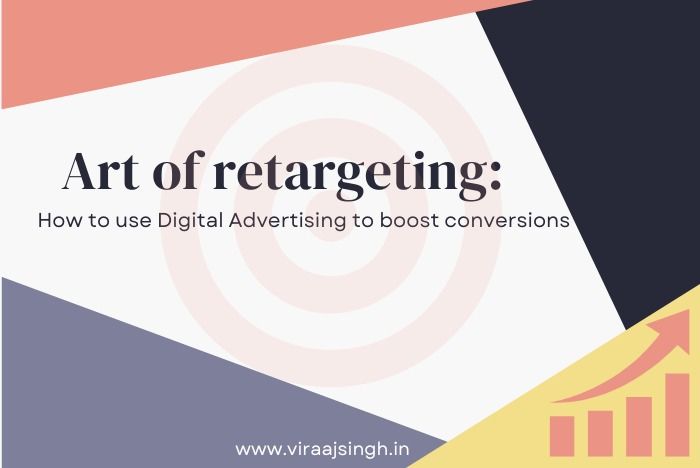Re-targeting is an essential element of digital advertising. It helps businesses increase brand awareness, improve conversion rates, and enhance customer loyalty. In this article, we’ll look at the positive impacts of re-marketing. Provide tips for creating an effective re-targeting strategy. Highlight best practices to follow. Discuss common mistakes to avoid. Share some examples of successful re-targeting campaigns with ad creatives.
The Benefits of Re-targeting: Digital advertising and ad creatives can help businesses achieve the following benefits:
➢ Increased brand awareness:
Re-targeting reminds potential customers of your brand and keeps it top of mind.
➢ Improved conversion rates:
Re-targeting campaigns can help bring visitors back to your website and convert them into customers.
➢ Enhanced customer loyalty:
By re-targeting existing customers. You can strengthen your relationship with them and encourage repeat purchases.
➢ Higher ROI:
Re-targeting efforts frequently outperform other forms of advertising in terms of return on investment because they focus on customers who have already expressed interest in your business.
How to Create an Effective Re-targeting Strategy?
➮ Identify target audience:
Determine who is most likely to engage with your brand and create campaigns that specifically target them.
➮ Select the right re-targeting channels:
Consider which channels, such as Google, Facebook, or Instagram are most effective for your business and target audience. Plan marketing strategy according to the selected platform.
➮ Craft compelling ad creatives:
Use digital advertising to create ads that grab the attention of potential customers and motivate them to take action.
➮ Set up re-targeting campaigns:
Use a re-targeting platform or hire a digital marketing agency to set up and manage your campaigns.
➲ To ensure the success of your advertising campaigns and brand personalization, follow these best practices:
➮ Frequency capping:
Limit the number of times a user sees your ad to avoid annoying them.
➮ A/B testing ad variations:
Experiment with different ad creatives and messaging to determine which is most effective.
➮ Personalization:
Use data to personalize your ads and make them more relevant to the user.
➮ Cross-selling and up-selling:
Re-target existing customers with complementary products or services.
● Avoid these common re-targeting mistakes:

➮ Stalking users with too many ads:
Limit the frequency of your ads to avoid annoying potential customers.
➮ Using generic ad creatives:
Create ads that are specific to the user’s behavior and interests.
➮ Ignoring mobile optimization:
Make sure your advertisements are mobile-friendly.
➮ Failing to exclude converters:
Exclude users who have already converted from your re-targeting campaigns.
➲ To measure the success of your advertising campaigns and brand personalization, monitor the following metrics:
➮ Impressions:
The amount of times your advertisement is displayed to prospective customers.
➮ Click-through rate (CTR):
The proportion of users who engage with your ad.
➮ Conversion rate:
The percentage of users who convert after clicking on your ad.
➮ Return on ad spend (ROAS):
The revenue produced by your ad in comparison to the expense of the advertisement.
➲ Examples of Successful Retargeting Campaigns:
Here are some examples of successful retargeting campaigns that demonstrate the effectiveness of digital advertising and brand personalization.
➮ Sephora:
Sephora re-targeted users who had browsed specific products and achieved a 50% higher click-through rate and a 33% higher conversion rate.
➮ Airbnb:
Airbnb re-targeted users who had abandoned their booking process and achieved a 30% higher conversion rate.
➮ Spotify:
Spotify retargeted users who had abandoned their free trial and achieved a 30% higher conversion rate.
Retargeting is a crucial aspect of digital marketing that can help re-engage your audience and boost conversions. By implementing an effective retargeting strategy and following best practices. You can create compelling ad campaigns that resonate with your target audience and drive results.
We hope this post has given you valuable insights into the art of retargeting and how to use it to re-engage your audience and boost conversions.
Don’t hesitate to implement retargeting in your marketing strategy and track your results to see the impact it can have on your business. Follow www.viraajsingh.in for more digital marketing updates.
At a glance:
▹ Retargeting is important for re-engaging your audience and boosting conversions
▹ Benefits of retargeting include increased brand awareness, improved conversion rates, enhanced customer loyalty, and higher ROI
▹ To create an effective retargeting strategy. Identify your target audience, select the right channels, craft compelling ad creatives, and set up campaigns
▹ Best practices include frequency capping, A/B testing, personalization, and cross-selling/upselling
▹ Common mistakes include over-stalking users, using generic ads, ignoring mobile optimization, and failing to exclude converters
▹ Metrics to monitor include impressions, CTR, conversion rate, and ROAS
▹ Successful retargeting campaigns provide inspiration and guidance for your future campaigns.







Leave a Reply